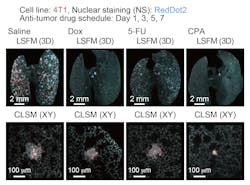Tissue clearing visualizes whole-body cancer metastasis at the single-cell level
A team of researchers at the RIKEN Quantitative Biology Center (QBic; Suita, Japan) and the University of Tokyo (UTokyo; Japan) have developed a method to visualize cancer metastasis in whole organs at the single-cell level. The method combines the generation of transparent mice with statistical analysis to create three-dimensional (3D) maps of cancer cells throughout the body and organs.
Related: 'Transparentizing' method enables quick whole-brain imaging at single-cell resolution
Recent research in optical clearing methods has made it possible to transparentize the bodies and organs of experimental animals. This has led to a new wave of anatomical studies that can combine tissue transparency with sophisticated cell-labeling techniques and light microscopy. Led by Hiroki Ueda at RIKEN QBiC/UTokyo and Kohei Miyazono at UTokyo, the team has focused their efforts on being able to visualize and profile cancer metastasis throughout the body.
The team first focused on finding the best refractive index for their clearing agent, which is called CUBIC. They tested a range of refractive indices and determined which one was the best. Next, when they used the CUBIC method with this refractive index (termed CUBIC-R) and combined it with different kinds of microscopy methods, they were able to detect metastasis of single cells throughout the body and organs of the mouse specimens.
Co-senior author Miyazono notes that this method is a bridge between in vivo imaging of live animals and conventional histology. "Although we cannot apply our new CUBIC-Cancer analysis to live animals, we were able to quantify metastatic cells very early in formation. This will be a very powerful tool for evaluating the effectiveness of anti-cancer drugs."
The team tested this hypothesis by treating mice with anti-cancer drugs and using CUBIC-Cancer analysis to profile their effectiveness. They were able to detect differences in the total volume and number of cancer colonies throughout the lungs of the mice. The technique was even able to detect individual cancer cells. As co-first authors Shimpei Kubota and Kei Takahashi explain, "this is very promising because these cells might be dormant or resistant to anti-cancer drugs. As just one surviving cancer cell can lead to tumor metastasis, being able to use CUBIC-Cancer analysis to evaluate drug effectiveness at this level is going to be a very useful and practical application."
Full details of the work appear in the journal Cell Reports.
